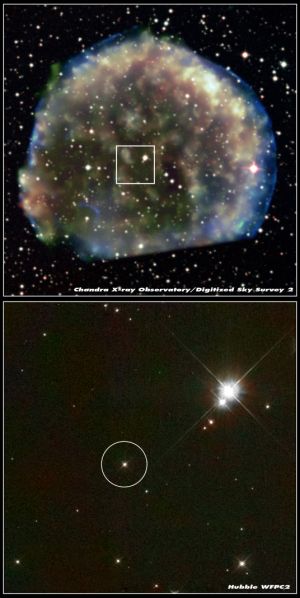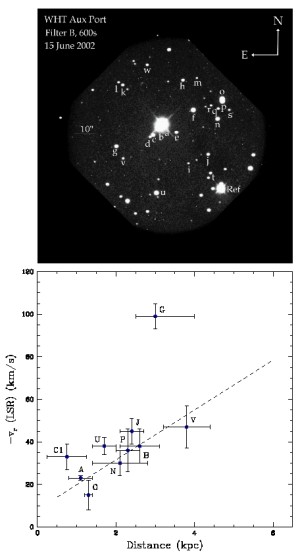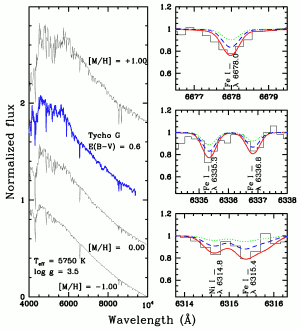|
|  |
Type Ia supernovae are very important stellar phenomena. They are
the most homogenous type of explosions in the Universe, and they are
so bright that they are visible billions of light years away. They have
led to the important discovery of the accelerated expansion of the Universe,
unveiling the presence of a new form of energy driving the expansion.
Despite their importance, little was known about the systems producing
those explosions.
It is known that a Type Ia supernova occurs when a carbon--oxygen white
dwarf grows in mass by the accretion of matter from a stellar companion
reaching the critical conditions in its interior that lead to thermonuclear
runaway. Though the exploding star is identified as a white dwarf, many
possibilities have been theoretically suggested for the companion, the
triggerer of the explosion. Unless the companion star is another white dwarf,
in which case it should be destroyed by the mass-transfer process itself, this
companion star should survive and show distinguishing properties,
being at the distance of the supernova and moving with a peculiar
velocity as a result of the disruption of the orbital system in the explosion.
Tycho Brahe's supernova --- the Type Ia supernova observed by Tycho Brahe and
other astronomers in 1572 --- offered a unique opportunity to
observationally address the identification of the surviving companion
of this type of stellar explosions.
This task was carried out by an international collaboration of researchers,
led by Pilar Ruiz-Lapuente of the Max Planck Institute for Astrophysics
and the University of Barcelona. In a big survey the astronomers
gathered complete
information of the stars in the gaseous remnant of Tycho Brahe's supernova,
and classified them
in spectral type, luminosity class, metal content, distance, radial velocity
and proper motion on the sky.
Several years have been spent to obtain the information on those stars,
through the use of the telescopes of
the European Northern Observatory in La Palma, the W. M. Keck Telecopes on
Mauna Kea and the NASA/ESA Hubble Space Telescope.
As a result of this survey and its evaluation, the astronomers could
exclude as viable progenitors of this
Type Ia supernova a long list of candidates proposed before: Systems
in which the companion star donating gas to the exploding star
is a red giant star, a red supergiant, a subdwarf.
Instead, a high-velocity subgiant star close to the center of the
remnant, similar to our Sun in luminosity and color but slightly more
evolved, is found to be the likely surviving companion, the donor of matter
that triggered the explosion. The star, named Tycho G, is at the distance
of the supernova remnant and moves at more than three times the mean velocity
of the stars at that distance (Figure 1).
Identifying the progenitors of Type Ia supernovae
explosions is crucial task as it establishes the initial conditions
of the explosion and helps understanding the factors
that can affect their luminosity. This is of high importance
when Type Ia supernovae are used as standard candles for measuring
distances in the universe.
The velocities of all the stars near the center of the supernova
remnant were measured both in the direction of our
line of sight by measuring the Doppler shift of the lines in
the spectrum of the stars, and tangentially, across the sky, with the use of
the Wide Field Planetary Camera 2 on board of the Hubble Space
Telescope by taking images four years apart.
"Both radial and tangential velocities of Tycho G
are a factor three larger than the mean velocity of
stars at that location", Pilar Ruiz-Lapuente reports (Figure 2).
The metallicities of the stars, i.e. the enrichment of their gas with
elements other than hydrogen and helium, was also determined to
exclude that this star belongs to the stellar populations of
the halo or thick disk of the Milky Way. Those stars move also with
high velocities, but they have much lower metallicities than stars of
the galactic plane. "Although the region where Tycho Brahe's supernova
exploded is very deprived of such stars it was suspected that Tycho G
could still be a fast halo star", Pilar Ruiz-Lapuente says.
"However, the high content of nickel
and iron in the gas of Tycho G clearly identifies it as a star born
in the galactic plane" (Figure 3).
The space velocity of Tycho G is 136 km s-1. Such a
peculiar velocity agrees with those expected from the disruption of a
binary system consisting of a white dwarf and a subgiant or
main-sequence star with roughly a solar mass --- a system that has
resembled the recurrent nova U Scorpii. This discovery connects Type
Ia supernova explosions to `cataclysmic variable phenomena',
i.e. binary stars which exchange mass, and ties a loose end in stellar
evolution.
Pilar Ruiz-Lapuente
Original publication
"The binary progenitor of Tycho Brahe's 1572 supernova"
P. Ruiz-Lapuente, F. Comeron, J. Mendez, R. Canal, S.J. Smartt,
A. V. Filippenko, R. L. Kurucz, R. Chornock, R. J. Foley, V. Stanishev
& R. Ibata, 2004. Nature 431, 1069-1072 (2004) (astro-ph/0410673)
Scientist of contact
 Pilar Ruiz-Lapuente
(Max-Planck Institut for Astrophysik and
Univ. Barcelona), Principal Investigator of the survey for the
progenitor of Tycho Brahe's supernova. Pilar Ruiz-Lapuente
(Max-Planck Institut for Astrophysik and
Univ. Barcelona), Principal Investigator of the survey for the
progenitor of Tycho Brahe's supernova.
Literature
Also on this supernova:
The research on the historical observations done
in the XVI century shows that this Type Ia supernova was of very
common type in luminosity within this family of events:
P. Ruiz-Lapuente, 2004, Astrophysical Journal, 612, 357
On Type Ia supernovae:
F. K. Röpke and W. Hillebrandt, 2005, Astronomy and Astrophysics, 431, 635
W. Hillebrandt and J.C Niemeyer, 2000, Annual Review of Astronomy and Astrophysics, 38, 191
Links
 Chandra/Hubble pictures of Tycho Brahe's supernova Chandra/Hubble pictures of Tycho Brahe's supernova
 ESA press release ESA press release
 Three-dimensional simulations of type Ia supernova explosions Three-dimensional simulations of type Ia supernova explosions
 SN Ia Research Training Network SN Ia Research Training Network
|




